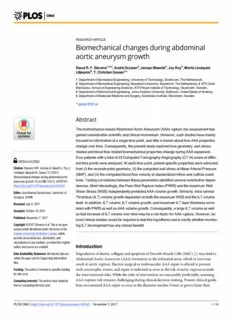
Biomechanical changes during abdominal aortic aneurysm growth PDF
Preview Biomechanical changes during abdominal aortic aneurysm growth
RESEARCHARTICLE Biomechanical changes during abdominal aortic aneurysm growth RaoulR.F.Stevens1,2,3,AndriiGrytsan3,JacopoBiasetti4,JoyRoy5,MoritzLindquist Liljeqvist5,T.ChristianGasser3* 1 DepartmentofBiomedicalEngineering,UniversityofTechnology,Eindhoven,TheNetherlands, 2 DepartmentofBiomedicalEngineering,MaastrichtUniversity,Maastricht,TheNetherlands,3 KTHSolid Mechanics,SchoolofEngineeringSciences,KTHRoyalInstituteofTechnology,Stockholm,Sweden, 4 DepartmentofMechanicalEngineering,JohnsHopkinsUniversity,Baltimore,UnitedStatesofAmerica, 5 DepartmentofMolecularMedicineandSurgery,KarolinskaInstitute,Stockholm,Sweden *[email protected] a1111111111 Abstract a1111111111 a1111111111 Thebiomechanics-basedAbdominalAorticAneurysm(AAA)ruptureriskassessmenthas a1111111111 gainedconsiderablescientificandclinicalmomentum.However,suchstudieshavemainly a1111111111 focusedoninformationatasingletimepoint,andlittleisknownabouthowAAAproperties changeovertime.Consequently,thepresentstudyexploredhowgeometry,wallstress- relatedandbloodflow-relatedbiomechanicalpropertieschangeduringAAAexpansion. Fourpatientswithatotalof23ComputedTomography-Angiography(CT-A)scansatdiffer- OPENACCESS enttimepointswereanalyzed.Ateachtimepoint,patient-specificpropertieswereextracted Citation:StevensRRF,GrytsanA,BiasettiJ,RoyJ, from(i)thereconstructedgeometry,(ii)thecomputedwallstressatMeanArterialPressure LindquistLiljeqvistM,GasserTC(2017) (MAP),and(iii)thecomputedbloodflowvelocityatstandardizedinflowandoutflowcondi- Biomechanicalchangesduringabdominalaortic tions.Testingcorrelationsbetweentheseparametersidentifiedseveralnonintuitivedepen- aneurysmgrowth.PLoSONE12(11):e0187421. https://doi.org/10.1371/journal.pone.0187421 dencies.Mostinterestingly,thePeakWallRuptureIndex(PWRI)andthemaximumWall ShearStress(WSS)independentlypredictedAAAvolumegrowth.Similarly,Intra-luminal Editor:JoseManuelGarciaAznar,Universityof Zaragoza,SPAIN Thrombus(ILT)volumegrowthdependedonboththemaximumWSSandtheILTvolume itself.Inaddition,ILTvolume,ILTvolumegrowth,andmaximumILTlayerthicknesscorre- Received:July5,2017 latedwithPWRIaswellasAAAvolumegrowth.Consequently,alargeILTvolumeaswell Accepted:October19,2017 asfastincreaseofILTvolumeovertimemaybeariskfactorforAAArupture.However,tai- Published:November7,2017 loredclinicalstudieswouldberequiredtotestthishypothesisandtoclarifywhethermonitor- Copyright:©2017Stevensetal.Thisisanopen ingILTdevelopmenthasanyclinicalbenefit. accessarticledistributedunderthetermsofthe CreativeCommonsAttributionLicense,which permitsunrestricteduse,distribution,and reproductioninanymedium,providedtheoriginal authorandsourcearecredited. Introduction DataAvailabilityStatement:Allrelevantdataare Degradationofelastin,collagenandapoptosisofSmoothMuscleCells(SMC)[1]mayleadto withinthepaperanditsSupportingInformation AbdominalAorticAneurysm(AAA)formationintheinfrarenalaorta,whichinturnmay files. resultinaorticrupture.ElectivesurgicalorendovascularAAArepairisofferedtoprevent Funding:Theauthorsreceivednospecificfunding suchcatastrophicevents,andrepairisindicatedassoonastheriskofaorticruptureexceeds forthiswork. theinterventionalrisks.Whiletherisksofinterventionarereasonablypredictable,assessing AAAruptureriskremainschallengingduringclinicaldecisionmaking.Presentclinicalguide- Competinginterests:Theauthorshavedeclared thatnocompetinginterestsexist. linesrecommendAAArepairassoonasthediameterreaches55mmorgrowsfasterthan PLOSONE|https://doi.org/10.1371/journal.pone.0187421 November7,2017 1/16 BiomechanicalchangesduringAAAgrowth 10mm/year[2,3],anddiameterremainsthemostimportantsurrogatemarkerofAAArisk[4]. However,aconsiderableportionofAAAsrupturebelowthesizeof55mm(especiallyinfemale patientsandcurrentsmokers[5]),whereasmanyaneurysmslargerthan55mmneverrupture [6–8].Consequently,amorerobustAAAruptureriskassessmentwouldbeofgreatclinical value. TheBiomechanicalRuptureRiskAssessment(BRRA)quantitativelyintegratesmany knownriskfactorsforAAArupture,allowingamoreholisticriskassessment.TheBRRAhas gainedconsiderablemomentum[9–18],butthederivedindicesareessentiallybasedoninfor- mationatasingletimepoint,andcurrentlylittleisknownabouthowAAAbiomechanical parameterschangeovertime. AlmostallclinicallyrelevantAAAscontainanintra-luminalthrombus(ILT)[19]com- posedoffibrinandbloodcells.TheroleofILTisstillcontentious,butitisthoughttoplayan importantroleinAAAprogression.DespiteILTtissuebeingseveraltimessofterthanthe AAAwall,itmaybelargeinvolume,andthushavingasignificantstructuralimpactonAAA biomechanics.Numerical[20,21]andin-vitroexperimental[22]studiesreportedILT’sstruc- turalimpact,andthelocationofPeakWallStress(PWS)hasbeenassociatedwiththesiteof smallestILTlayerthickness[23].Consequently,athrombuslayermayprotectthevesselwall fromrupturebyactingasastressbuffer[20,22],thusdecreasingtheruptureriskoftheaneu- rysm.However,whengrowingtoothick,theILTlayercancausethewalltoweaken,forexam- pleduetohypoxia[24].TheILTalsoprovidesanidealenvironmentforproteolyticagents [25].ThesechemicalscanbeconveyedthroughtheporousILT[26,27]anddiminishwall strengthbyproteolyticdegradationofelastinandcollagen.Suchawallweakeningmechanism couldexplainwhyathickILTlayer[28]andfastincreaseinILTvolume[29]havebeenlinked toAAArupturerisk.ArecentCT-A-basedstudy[30]reportedsomeconsequencesforAAA growththatmightbelinkedtobothaforementioned(competing)ILT-basedmechanisms.The studyfoundslowestAAAwallexpansionbehindanaboutsevenmillimeterthickILTlayer,i.e. ILT-basedstressbufferingseemstobefullycompensatedbyILT-basedwallweakeningonce theILTlayerreachedthisthickness. Thepresentstudyaimsatinvestigatinghowgeometry,wallstress-relatedandbloodflow- relatedbiomechanicalpropertieschangeduringAAAexpansion.Despitethefactthateffects ofbloodflowonAAAgrowthhavebeenreported[31],theinteractionbetweenthesefactorsis stillpoorlyunderstood.Knowledgeaboutthetimecourseofsuchparametersmayleadtoa betterestimateofAAAruptureriskandimprovemonitoringprotocolsofAAApatients. Materialsandmethods Patientcohort TheuseofanonymizedpatientdatawasapprovedbytheKarolinskaInstituteethicscommit- tee.AAApatientsfromKarolinskaUniversityHospital,Stockholm,Swedenwithatleastfive highresolutionComputedTomography-Angiography(CT-A)scanrecordingswithinthelast 10yearswereincluded.MostoftheCT-Ascanswereperformedfordiagnosticpurposesand AAAsurveillance.PatientcharacteristicsarelistedinTable1.Toavoidtemporalfluctuations, thebloodpressurewasaveragedoverallavailablemeasurements. Geometricalanalysis Theaortawassemi-automaticallysegmentedbetweentherenalarteriesandtheaorticbifurca- tion(A4clinicsResearchEdition,VASCOPSGmbH,Graz,Austria).Segmentedgeometries includedluminalandexteriorAAAsurfacesandusedapredefinedwallthicknessthat accountedforthereportedwallthinningbehindtheILT[28].Specifically,inordertoaccount PLOSONE|https://doi.org/10.1371/journal.pone.0187421 November7,2017 2/16 BiomechanicalchangesduringAAAgrowth Table1. PatientcharacteristicsandtimelineofComputedTomography-Angiography(CT-A)scans. PatientID Ageinyearsatbaseline Gender Bloodpressure(mmHg) NumberofCT-Ascans(n)andfollow-uptimesinyearsfrombaseline A 76 male 140/80 (5)0/0.7/2.2/2.7/3.9 B 64 female 207/113 (5)0/2.0/3.0/4.0/5.9 C 63 male 160/100 (7)0/0.6/1.5/2.7/4.2/5.3/8.4 D 73 female 140/80 (6)0/0.3/0.6/1.3/3.5/3.7 https://doi.org/10.1371/journal.pone.0187421.t001 foramoderatewallthinningbehindtheILTlayer,thewallthicknesswassettoH ¼ (cid:2) (cid:3) WALL max 1:5(cid:0) 0:17H mmwithH denotingthelocalthicknessoftheILTlayerinmillimeters. 25 ILT ILT Suchpredefinedvaluecomparesreasonablyto1.56mm,anaveragevaluereportedinthelitera- ture,seeTable2inanotherstudy[32].Thereproducibilityoftheappliedmethodhasbeen reportedpreviously[33–35],andatypicalAAAsegmentationisshowninFig1A.Themaxi- mumdiameter(d ),themaximumILTlayerthickness(H ),andluminal(V ), max ILTmax lum thrombus(V )andtotal(V )volumeswerecalculatedforeachaorticgeometry.SeeTable2 ILT tot forfurtherdetails. Structuralanalysis Non-linearFiniteElement(FE)modelswereusedtocomputethestressintheAAAwallat MeanArterialPressure(MAP).PeakWallStress(PWS),i.e.thehighestvonMisesstressinthe aneurysmwall,wasextractedfromeachsimulation(A4clinicsResearchEdition,VASCOPS GmbH,Graz,Austria).TheFEmodelusedhexahedral-dominatedfiniteelementsofQ1P0for- mulation[38]toavoidvolumelockingofincompressiblesolids.TheAAAwasfixedatthe Table2. Definitionofgeometricalandbiomechanicalparameters. Boldfacenotationdenotesvectorortensorquantities,andtheregionofinterestwas (manually)specifiedbetweenthelowerleveloftherenalarteriesandtheupperleveloftheaorticbifurcation,respectively. Notation Description Remark Geometricalparameters d Maximumouterdiameterperpendiculartotheluminalcenterline max H MaximumthicknessoftheIntra-LuminalThrombus(ILT)layer,i.e.maximumdistancebetweenwall-ILT ILTmax interfaceandtheluminalsurface V ,V V Volumesofthelumen,ILTandthetotalvessel. lum ILT, tot Structuralbiomechanicalparameters PWS PeakWallStress.HighestvonMisesstressinthewallallovertheAAA PWS=max[Wallstress] h i PWRI PeakWallRuptureIndex.Highestratiobetweenthecalculatedwallstressandtheestimatedwallstrength PWRI¼max Wallstress allovertheAAA. Wallstrength Hemodynamicbiomechanicalparameters v ,v , Minimal,maximalandmeanmagnitudeofthebloodflowvelocity.Themeanbloodflowvelocityisderived v =min[|v|]; min max min v byaveragingthemagnitudeofthebloodflowvelocityvoverthetimeTofthecardiaccycle,aswellasthe v =max[|v|]; mean mZax(cid:20) Z (cid:21) volumeofthelumenVlum v ¼1 T 1 Vlumjvjdv dt mean T 0 Vlum 0 g_ ;g_ Minimalandmaximalscalarshearratesoverthecardiaccycle.Thesequantitiesarederivedfromthe g_ ¼min½g_(cid:138); g_ ¼max½g_(cid:138) min max min pffiffiffiffiffimffiffiaffixffiffiffiffiffiffiffiffi spatialvelocitygradientgradv,i.e.aquantitythatdenoteshowfastthebloodvelocitychangesinspace. withg_ ¼ 2l l and symsym l =(gradv+gradTv)/2 sym WSS , MinimalandmaximalmagnitudeoftheWallShearStress(WSS)vectorWSSoverthecardiaccycle.WSS WSS =min[|WSS|] min min WSS denotesthemechanicalstressinducedbybloodflowontoblood-tissue(wallorILT)interface. WSS =max[|WSS|] max max (cid:0) (cid:1) OSI OscillatoryShearIndex.TheOSIiscomputedfromtheaveragedmagnitudeofWSSanditsmagnitude| OSI¼1 1(cid:0) jAWSSVj WSS|.TheOSIdenotesoscillatorybehavioroftheflowcausedbycomplexflowpatterns.Specifically,the withAWSS2¼1RTAWjWSSSSjdt extremecasesOSI=1andOSI=0denoteoscillatinganduni-directionalflows,respectively. T 0R andAWSSV¼1 TWSSdt T 0 https://doi.org/10.1371/journal.pone.0187421.t002 PLOSONE|https://doi.org/10.1371/journal.pone.0187421 November7,2017 3/16 BiomechanicalchangesduringAAAgrowth Fig1.Analysismethodperformedforeachpatientateachtimepoint.(a)LateralComputedTomography- Angiography(CT-A)slicewithsegmentedAbdominalAorticAneurysm(AAA).Yellow,blueandgreencurves denotetheluminalsurface,exteriorsurfaceandwall-thrombusinterface,respectively.(b)Ruptureriskindexplot derivedfromthestructuralbiomechanics-basedanalysisatMeanArterialPressure(MAP).(c)WallShearStress distributionatt=0.25softhecardiaccyclederivedfromaComputationalFluidDynamics(CFD)computation.At theinletandtheoutlets,theindicatedvolumeflowrateandpressureversustimeresponseswereprescribed [36,37]. https://doi.org/10.1371/journal.pone.0187421.g001 renalarteriesandattheaorticbifurcation,andnocontactwithsurroundingorganswascon- sidered.Isotropicconstitutivedescriptionsfortheaneurysmwall[39]andtheILT[27]were assignedtoeachmodelwiththeILTstiffnessgraduallydecreasingfromtheluminaltothe abluminalsites[27].Specifically,theAAAwallwasassumedtobehomogenousandmodeled bythetwo-parameterYeohstrainenergyfunctionψ=c (I −3)+c (I −3)2withI =trC 1 1 2 1 1 denotingthefirstinvariantoftherightCauchy-GreenstrainC.Here,thematerialparameters c =77kPaandc =1881kPahavebeenused,i.e.valuesidentifiedfromin-vitroAAAwall 1 2 P testing[39].TheILTwasmodeledbyanOgden-typestrainenergyfunctionc¼c 3 ðl4(cid:0) i¼1 i 1Þwithλ,i=1,2,3denotingtheprincipalstretches.TheconstitutivepropertiesoftheILTare i (cid:2) (cid:3) capturedbyc¼max 2:62(cid:0) 0:89H ;1:73 kPawithH denotingthelocalthicknessofthe 25 ILT ILT ILTlayerinmillimeters.Thisexpressionaccountsforthegradualdecreaseofstiffnessfrom theluminaltotheabluminallayer,i.e.asreportedfromin-vitrotestingofILTtissue[27].The wall-ILTinterfacewasrigid,i.e.ILTandAAAwalldisplacementsmatchedattheirinterface. AwallruptureriskindexwasdefinedbylocallydividingthevonMiseswallstresstoanesti- mateofwallstrength.AAAwallstrengthwasassignedinhomogeneouslyandestimatedbya scaledversion[18,34]ofthestrengthmodelproposedpreviously[12].Finally,thehighestwall riskindex,orPeakWallRuptureIndex(PWRI),wasextracted.Inordertoavoidpickingup PWRIartefacts,A4clinicsResearchEditionaveragesoverasufficientlylargenumberofFE nodes,i.e.locationswherethewallruptureriskindexiscomputed.Inaddition,PWRIlocation isindicatedinthesoftwarewindow,sothattheusercandisregardidentifiedartefacts.Fig1B illustratesthetypicaldistributionofthewallruptureriskindex,andTable2detailstheinvesti- gatedstructuralbiomechanicalparameters. Hemodynamicalanalysis RigidwallComputationalFluidDynamics(CFD)models(ANSYSCFX,ANSYSInc.US)with reportedinflowandoutflowconditions[36,37]wereusedtopredictthebloodflowvelocity. Specifically,attheinlet,aplugvelocityprofilewasderivedfromtheinflowvolumerate,andat PLOSONE|https://doi.org/10.1371/journal.pone.0187421 November7,2017 4/16 BiomechanicalchangesduringAAAgrowth bothoutlets,thepre-definedpressurewasused.Inflowvolumerateandoutletpressurewave havebeentakenfromtheliterature[37].Theno-slipboundaryconditionwasprescribedall alongtheluminalsurface.TheAAAlumenwasmeshedwithtetrahedralfinitevolumeele- ments(about2mminsize),andfivelayersofprismelements(layerthicknessrangingfrom 0.1mmto0.2mm)aimedatcaptureboundarylayerflow.Estimatesontherequiredmeshsize werebasedonourpreviousCFDwork[36].Specifically,ameshsensitivityanalysis[40]com- paredvelocity,pressure,andWSSattenpoints,toassesstherelationbetweendiscretization errorandelementsize. Thecontinuityandmomentumequationweresolvedwithinthesegmentofthevascular lumenthathasbeensegmentedfromCT-Aimages;intotalfivecardiaccycleswithbloodof densityr¼1050kg weresimulated.Inaddition,blood’sshear-thinningviscousproperties m3 werecapturedbytheCarreau-Yasudaviscositymodelm¼m þðm (cid:0) m Þ½1þðlg_Þa(cid:138)n(cid:0)a1. 1 0 1 Here,g_ denotesthescalarshearrate,andμ =0.16Pasandμ =0.0035Passpecifiedblood 0 1 viscosityatlowandhighshearrates,respectively.Inaddition,thetimeconstantλ=8.2s,the powerlawindexn=0.2128,andtheYasudaexponenta=0.64havebeenused.Theseparame- tersrepresentbloodviscosityofbloodat37degreesCelsius,andhavebeenusedpreviously [41,42].FurtherdetailsregardingtheappliedCFD,especiallyregardingverifyingtheplausibil- ityofthepredictions,aregivenelsewhere[43]. Hemodynamicsparameterswereextractedfromthefifthcalculatedcardiaccycleandinside theaneurysmaticvesseldomain(MATLAB,TheMathWorksInc.,Natick,Massachusetts, USA).Specifically,theminimal(v ),maximal(v )andmean(v )bloodflowvelocities, min max mean minimal(g_ )andmaximal(g_ )scalarshearrates,minimal(WSS )andmaximal min max min (WSS )WallShearStresses(WSS),aswellastheOscillatoryShearIndex(OSI)[28,44]were max computed.ThedefinitionoftheseparametersislistedinTable2,andFig1Cillustratesatypi- calWSSdistribution,forexample. Dataanalysis Dataanalysisofbiomechanicalparameterswascarriedoutwithintheaneurysmaticportions oftheaorta.Theproximalborderoftheaneurysmaticdomainwasdefinedbythevesselsec- tionatwhichtheaortawasatleast10%largerthanthenormal(nonaneurysmatic)aorta.The distalborderwasset2.0cmproximaltotheaorticbifurcation. Theratesofchangeovertimeofthegeometrical,structuralandhemodynamicalwerealso investigated.Atgiventimepoint,suchquantitieswerecalculatedasthearithmeticdifference betweentwoconsecutiveCT-Ascansanddividedbythetimebetweenthescans.Therateof changeofparameterXwasdenotedbyΔX. Pooleddatafromallpatientswerestatisticallyanalyzed(SPSS,IBMCorp.Released2013. IBMSPSSStatistics,Armonk,USA).AllparametersweretestedfornormalityusingtheSha- piro-Wilktest(significancelevel:p<0.05),andPearsonandSpearman’scorrelationtests(sig- nificancelevel:p<0.05)wereusedtoinvestigatesimplecorrelationamongnormalandnon- normaldistributedparameters,respectively.Analysisofvariance(ANOVA)wasusedtoassess thestatisticalsignificanceofmultivariatelinearregressions. Results Acompleteanalysisofasinglecaseatonetimepointtookabouttenhours.Figs2and3illus- tratethedevelopmentofthewallruptureriskindexandWSSovertimeforallfourpatients, respectively. PLOSONE|https://doi.org/10.1371/journal.pone.0187421 November7,2017 5/16 BiomechanicalchangesduringAAAgrowth Fig2.DevelopmentovertimeofthewallruptureriskindexatMeanArterialPressure(MAP)inallfourAbdominalAortic Aneurysm(AAA)patients. https://doi.org/10.1371/journal.pone.0187421.g002 PLOSONE|https://doi.org/10.1371/journal.pone.0187421 November7,2017 6/16 BiomechanicalchangesduringAAAgrowth Fig3.DevelopmentovertimeoftheWallShearStress(WSS)att=0.25softhecardiaccycle,i.e.atthetimeofpeakbloodinflow,inallfour AbdominalAorticAneurysm(AAA)patients.NotethatthistimepointdoesnotcorrelatewiththetimewhenWSSpeakswithintheaneurysmaticportion oftheaorta. https://doi.org/10.1371/journal.pone.0187421.g003 PLOSONE|https://doi.org/10.1371/journal.pone.0187421 November7,2017 7/16 BiomechanicalchangesduringAAAgrowth Fig4.Developmentofthemaximumdiameterd andthePeakWallRuptureIndex(PWRI)in max AbdominalAorticAneurysm(AAA)patientsAtoD.Eachtimepointislabeledwiththetimeinyearsfrom baseline.Forcomparison,theblacksolidcurvedenotesthePWRIversusd characteristicsthatinaverageis max seeninAAApatients.Dottedcurvesdenotethe5%and95%confidenceintervals,respectively. https://doi.org/10.1371/journal.pone.0187421.g004 Diameterandbiomechanicalruptureriskindex PWRIandd variedconsiderablyovertime(Fig4).AAACisratherstableandslightly max belowthemeanPWRIversusdiametercurve.Atbaseline,AAABhasaslightlysmallerdiame- terthanAAAC(49mmversus52mm)butahigherPWRI,andwithin5.9yearsitsdiameter growsupto60mm.Interestingly,PWRIincreasesrapidlyatfirstbutslightlydecreaseslater. CaseDisrathersmallatbaseline(42mm)ataPWRIbetweenthecasesBandC.After3.5years thediameterincaseDreaches48mm,butsubsequentlybothdiameterandPWRIreduce. AAAAisalreadylargeatbaseline(71mm),andwithin2.2yearsitsdiametergrowsto82mm, subsequentlyshrinkingbyabout4mm. Correlationanalysis Simplecorrelationanalysis. Tables3–6summarizetheresultsfromthesimplecorrela- tionanalysis,andFig5A–5Dillustrateskeyfindingswithrespecttod .Interestingly,d max max Table3. Correlationsofgeometricalandbiomechanicalparameterswiththemaximumdiameterd max (resultsarebasedonsimplecorrelationanalysis). Correlationcoefficient p-value H 0.755 <0.001 ILTmax V ;V ;V 0.968;0.936;0.822 <0.001;<0.001;<0.001 lum tot ILT PWS 0.891 <0.001 PWRI 0.672 0.002 γ_ ; γ_ -0.773;-0.554 <0.0010.014 min mean WSS ;WSS -0.698;-0.459 0.001;0.048 max mean OSI 0.768 <0.001 v ;v -0.695;-0.519 <0.001;0.023 min mean ΔV ;ΔV 0.646;0.501 0.003;0.029 tot ILT https://doi.org/10.1371/journal.pone.0187421.t003 PLOSONE|https://doi.org/10.1371/journal.pone.0187421 November7,2017 8/16 BiomechanicalchangesduringAAAgrowth Table4. CorrelationsofgeometricalandbiomechanicalparameterswiththeILTvolumeV (results ILT arebasedonsimplecorrelationanalysis). Correlationcoefficient p-value H 0.964 <0.001 ILTmax V ;V 0.804;0.941 <0.001;<0.001 lum tot PWS 0.640 0.003 PWRI 0.693 0.001 γ_ ; γ_ -0.866;-0.580 <0.001;0.009 min mean WSS ;WSS -0.829;-0.559 <0.001;0.013 max mean OSI 0.518 0.023 v -0.584 0.009 mean ΔV ;ΔV 0.750;0.605 <0.001;0.006 tot ILT https://doi.org/10.1371/journal.pone.0187421.t004 didnotcorrelatewithdiametergrowthΔd (Fig4A).Insteadd correlatedwithvolume max max growthΔV ,wallshearstressWSS ,andthebiomechanicalriskindexPWRI(Fig5B–5D). tot max Moreover,trivialcorrelationsbetweenthediameterandvolumes(V ,V andV )were lum tot ILT found. Thescalarshearratesg_ andg_ aswellasthewallshearstressesWSS (Fig5E)and min mean max WSS correlatednegativelywithV .Incontrast,thebiomechanicalriskindexPWRI(Fig mean ILT 5F)andtheOscillatoryShearIndexOSIshowedpositivecorrelationswithV .Inaddition, ILT themeanbloodflowvelocityv correlatednegativelywithV . mean ILT Withrespecttogrowthparameters,themaximumILTthicknessH correlatedwith ILTmax totalvolumegrowthΔV (Fig6C).Inaddition,PWRI(Fig6B)andOSIcorrelatedpositively, tot whileg_ (Fig6A)correlatednegativelywithΔV .Finally,simpleregressionwithrespectto min tot theILTgrowthΔV ,exhibitedcorrelationswithv ,PWRI(Fig6D),H (Fig6C)and ILT max ILTmax g_ (Table3). max Allidentifiedcorrelationsaregiveninthesupportinginformationsection. Multiplecorrelationanalysis. MultiplelinearregressionshowedthatbothWSS max (p=0.004)andPWRI(p=0.001)areindependentpredictorsofvesselvolumegrowth.Specifi- cally,volumegrowthincreasedwithlowWSS andhighPWRIfollowingtherelation max ΔV =a +a WSS +a PWRIwithparametersa =−47.2(CI :−89.4/−5.0),a =−0.411 tot 0 1 max 2 0 90% 1 (CI :−1.713/0.892)anda =124.1(CI :69.4/178.7),whereCI denotesthe90%confi- 90%) 2 90%) 90% denceinterval. Similarly,highWSS (p=0.023)andV (p<0.001)independentlypredictedILTvol- max ILT umegrowthaccordingtoΔV =b +b WSS +b V withtheparametersb =−48.38 ILT 0 1 max 2 ILT 0 Table5. CorrelationsofgeometricalandbiomechanicalparameterswiththechangeofAAAvolume ΔV overtime(resultsarebasedonsimplecorrelationanalysis). tot Correlationcoefficient p-value H 0.804 <0.001 ILTmax V ;V ;V 0.697;0.773;0.750 0.001;<0.001;<0.001 lum tot ILT PWS 0.584 0.009 PWRI 0.799 <0.001 γ_ -0.615 0.005 min WSS -0.577 0.010 max OSI 0.475 0.040 v -0.477 0.039 min ΔV 0.694 0.001 ILT https://doi.org/10.1371/journal.pone.0187421.t005 PLOSONE|https://doi.org/10.1371/journal.pone.0187421 November7,2017 9/16 BiomechanicalchangesduringAAAgrowth Table6. CorrelationsofgeometricalandbiomechanicalparameterswiththechangeofILTvolume ΔV overtime(resultsarebasedonsimplecorrelationanalysis). ILT Correlationcoefficient p-value H 0.627 0.004 ILTmax V ;V ;V 0.625;0.666;0.605 0.004;0.002;0.006 lum tot ILT PWS 0.524 0.021 PWRI 0.696 0.001 γ_ ; γ_ 0.548;-0.471 0.015;0.042 max min v 0.734 <0.001 max ΔV 0.694 0.001 tot https://doi.org/10.1371/journal.pone.0187421.t006 (CI :−75.73/−21.03),b =2.169(CI :0.859/3.479)andb =0.541(CI :0.346/0.736), 90% 1 90% 2 90% respectively. Discussion Clinicalandexperimentalobservationshaveindicatedthatbiomechanicalconditionsinflu- encetheprogressionofaneurysmdisease[45,46].Despitetheseobservations,afundamental understandingoftheseinteractionsisstillmissing,particularlytheroleoftheILTinAAA pathology[25]iscontroversiallydiscussed.TheILTisanactivebiochemicalentity[25]that influenceswallstrength[12,24]andAAAprogression[30],butalsomechanicallyunloadsthe stressinthewall[20–22].Specifically,clinicalstudieshavelinkedathickILTlayer[28]and fastincreaseinILTvolume[29]toincreasedAAArupturerisk.Thepresentbiomechanical studysupportstheseobservationsthroughastrongpositivecorrelationofthebiomechanical riskindexPWRIwithbothILTvolumeV anditschangeovertimeΔV .Consequently, ILT ILT thesuitabilityofmonitoringILTvolume,anditschangeovertime,asadditionalriskindica- torsshouldbeexploredinlargerclinicalstudies. ILTformationrequiresplateletaccumulation,andforplateletstobeabletoadheretothe vessel,plateletsmustspendsufficienttimeinthevicinityofthrombogenicsurfaces.Therefore, theadhesionofplateletsmightbepromotedatsitesoflowWSS[43],i.e.aninverserelation- shipbetweenWSSandaneurysmexpansionmayexist.Suchaninverserelationshipiscon- firmedbyourstudythroughthenegativecorrelationofΔV withWSS.Similarconclusions tot havebeendrawnfromclinicalobservations,experimentalAAAmodels[46],andsimulation studies[31] ThepresentstudyfoundthatPWRIandWSS independentlypredictedthegrowthof max totalAAAvolumeΔV .PWRIisstronglyrelatedtothestressinthewall,andourfindingis tot supportedbypreviousexperimentalstudies[30]showingthatthegrowthofsmallAAAsis especiallysensitivetowallstress.DuetothelackofendothelialcellsinAAAs[28],bloodflow propertiesmayonlyindirectlypromoteAAAgrowththroughstimulationofthebiochemical environmentwithintheILT.Forexample,ahighOSIcouldsupportpumpingproteolytic agentsthroughtheporousILT,whichinturncouldpromoteAAAgrowth. Contrarytointuition,ourdatashowedthatthebiomechanicalriskdoesnotalwaysincrease intime.WallstressisstronglylinkedtoAAAshapeparameterslikeitsasymmetry[47]or, moregenerally,tothesurfacecurvatures[41].Consequently,ifgrowthappearstoreduceAAA asymmetry,thebiomechanicalriskforrupturealsoreduces,i.e.theaneurysmgrowsintoa shapeoflowerriskforrupture.ThefluctuationsinPWRIcouldalsobeexplainedbyreleasing spotsofhighsurfacecurvaturesofthewallthrough“cracking”ofwallcalcificationsduring AAAexpansion,forexample. PLOSONE|https://doi.org/10.1371/journal.pone.0187421 November7,2017 10/16
Description: